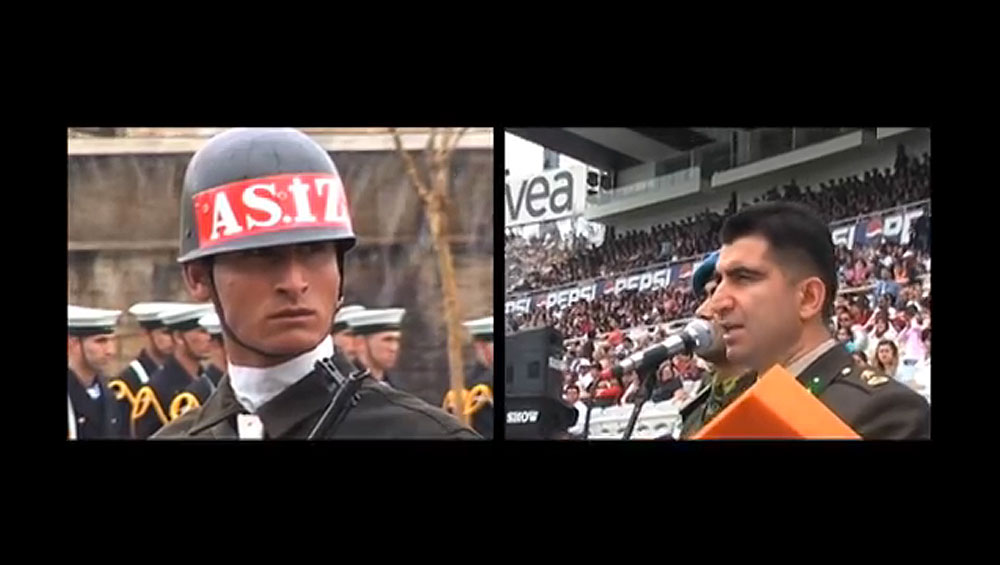
by LISA MORAVEC
Much has happened since Documenta 14 closed in Kassel in mid-September and before that in Athens. The financial overspending of €5.4m (£4.8m, $6.3m), according to the independent PriceWaterhouseCoopers report, was critically discussed in the press, leading to Documenta’s CEO, Annette Kulenkampff, stepping down. Despite the sensational international and local press coverage, some of the artworks exhibited at Documenta reflect the sociopolitical issues that the ambitious show tackled. One of these is Köken Ergun’s two-channel video I, Soldier (Ben Askerim) from 2005. It is a poetic documentary of Turkey’s National Youth and Sports Day, an event that, from 1919, has been held every year on 19 May to mark the anniversary of the beginning of the Turkish War of Independence led by Mustafa Kemal Atatürk. Today, the nationwide celebration includes dancing, marching, and speeches in streets and public squares; previously, members of the military and schoolchildren used to perform for the Turkish people inside large national stadiums.
In 2014, President Recep Tayyip Erdoğan ended the tradition of celebrating this event inside enclosed stadiums, and limited the celebration to open public spaces. I, Soldier, which belongs to Greece’s National Museum of Contemporary Art (known as EMST), was one of the rare videos exhibited at the Fridericianum to directly address issues that aligned artistic expression with national politics. In light of the failed coup in Turkey in 2016 and the strikingly grandiose celebration of the Turkish Republic Day on 29 October in 2017 outside of national stadiums, Ergun’s visually powerful documentary from 2005 opens up a space for a reflection on Turkish politics and the image of the military that goes beyond the framework of this year’s Documenta.
Lisa Moravec: Can you tell me more about the spectacular national celebration in Turkey that your work I, Soldier documents and how you became interested in it?
Köken Ergun: In 2005, I felt the need to record the annual 19 May celebration in Istanbul. Each city in Turkey used to stage its own celebration at a local stadium. High school students chosen from one school in that city produced these performances. Some of these schools were civilian and some were military. For this piece, I chose to focus on the performance of the military school in Istanbul. During my high school years, I was never selected to take part in these celebrations but, as civilian students, we were subject to patriotic poetry or marches, especially at the beginning or ending of the school week. I’ve always observed these scenes and found them too nationalistic and too macho. When I got older and was no longer a student, I looked back at it and “exorcised” my trauma of the republican education system by making a work about it. [The Turkish curator Vasıf Kortun used the term “exorcism” to describe Ergun’s work.]
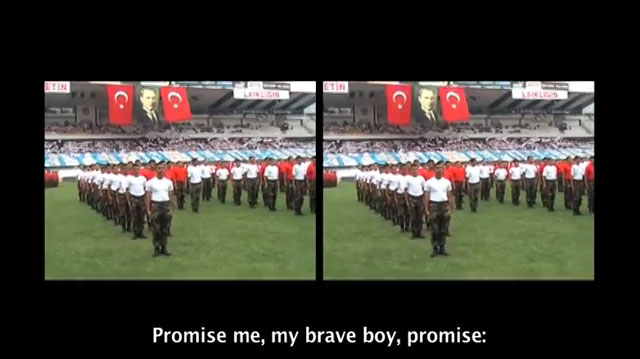
Köken Ergun. I, Soldier (Ben Askerim), 2005 (video still). Two-channel-video. © Köken Ergun.
LM: What exactly fascinated you about the athletic and ritual exercises performed by members of the Turkish military and pupils? Was it the extent to which they had been disciplined in order to perform skilled bodily exercises? Or was it more the controlled state mechanism within which they performed?
KE: Both. In nation states, the so-called “national education system” facilitates the turning of young people into citizens, and I think I had a problem with this doctrine when I was subjected to it. With this work, I wanted to show this general issue, and my personal problem with it, to a wider public.
LM: How was I, Soldier perceived in Turkey?
KE: I debuted the work in 2005 as part of the Hospitality Zone exhibition at the 9th Istanbul Biennial, which was curated by Halil Altindere within Charles Esche’s and Vasif Kortun’s biennial concept. The reactions there were ambiguous, as in any other country where I showed it. Some thought that I was supporting the military, some thought I was criticising it. I think this is the strength of the work because different audiences are differently attached to it. I obviously liked something about the ceremony, but I also carefully criticised it. Patriotic audiences usually look at this work with love. They say: “Wow, you show our soldiers very well.” Audiences that are critical of the state, the nation and the military look at it differently.
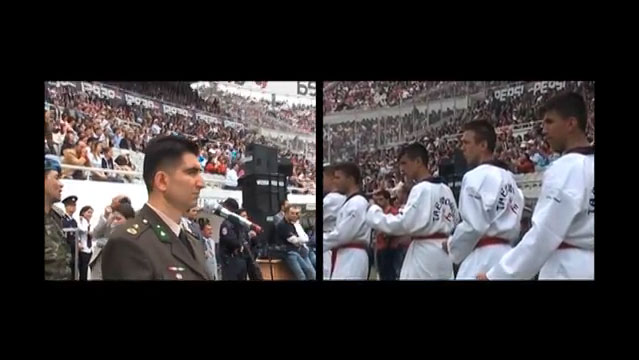
Köken Ergun. I, Soldier (Ben Askerim), 2005 (video still). Two-channel-video. © Köken Ergun.
LM: That is an interesting point. When I watched I, Soldier for the first time, in June at Documenta, it was the fine and powerful accord between the visuals and the sound that attracted me to it, although the subject matter is clearly disturbing. When was the work first presented outside Turkey and what reactions did it receive internationally?
KE: The video was first screened at the Oberhausen Short Film Festival in Germany and then at various other film festivals. I received a few awards for it. The reactions from the audience there were similar to those in Turkey.
LM: And then Greece’s National Museum of Contemporary Art in Athens (EMST) bought the work?
KE: Yes, that must have been in 2010.
LM: Let’s speak a bit more about Turkey, your home country. You were born in Istanbul in 1976 and grew up there, you studied there and in London, and now you are working on a PhD project at the Freie Universität in Berlin while living in Istanbul. When you try to recall the political climate in 2005, the year you made the work, in what way do you see it has changed? I don’t know if you attended the National Youth Ceremony each year, but perhaps you can nonetheless talk about how people’s stance towards the military and its function as a controlling state mechanism has changed over time.
KE: In 2005, the military was still a very important part of the state. It was not a military state per se. Rather, “the deep state” – that’s what we call it here – was operated within and with the military. Erdoğan came to power in 2002 as Turkey’s prime minister; he became president in 2014 with the promise that he would replace the military presence with a more participatory democracy. Many people were happy about him coming to power, but his promises did not materialise immediately. At the time when making this piece, the military was still strong and I was worried that I could become the target of the military, but that didn’t happen. I was, however, selective about where and when to show the video in Turkey. The context of the Istanbul Biennale was a more or less protected space, but, for example, I did not allow the national TV channel to broadcast I, Soldier.
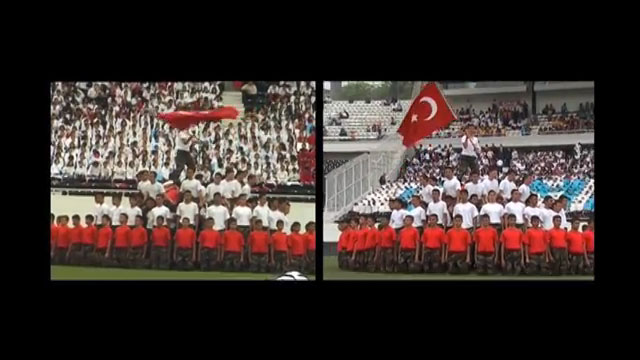
Köken Ergun. I, Soldier (Ben Askerim), 2005 (video still). Two-channel-video. © Köken Ergun.
LM: How has people’s approach towards the government, and consequently towards their belief in soldiers, changed since Erdoğan came to power in 2002?
KE: First, Erdoğan systematically started to work against the military. He limited its power in favour of democratic reforms. But gradually, he took over all the power in the system and trashed all the democratic reforms he had previously put in place. He now controls the judiciary and the army and the parliament and the police force, etc. In other words, he became all the things that he stood against before. This created a feeling of nostalgia among the public, a longing for the army. After all, a large percentage of the Turkish people were brought up with the idea that the army is the guarantor of a secular nation. These people are now joined by those who had previously been critical of the army and welcomed Erdoğan’s strategy of getting rid of it, but have since changed their minds after he took on the role of the army. So, now, many Turkish people, in fact, see the military as a hope for salvation from our current president.
Last year, a failed military coup against Erdoğan took place and that has brought the military and “the soldier” as a concept back into the public debate. In that sense, I, Soldier is really a contemporary work. When I made it, of course, I could not know that a military coup would happen in 2016, but I must have felt something about the continuity of the image of the soldier. This is a concept that is so heavily embedded within the Turkish culture that it cannot be erased easily. It is important to point out that, after Documenta 14 ended, Erdoğan unexpectedly declared himself the follower of Atatürk, and this October he staged a Republic Day celebration in an exaggerated way such as he had never done before. So we might also expect a comeback of other big national ceremonies, such as the National Youth and Sports ceremony taking place again inside large stadiums.
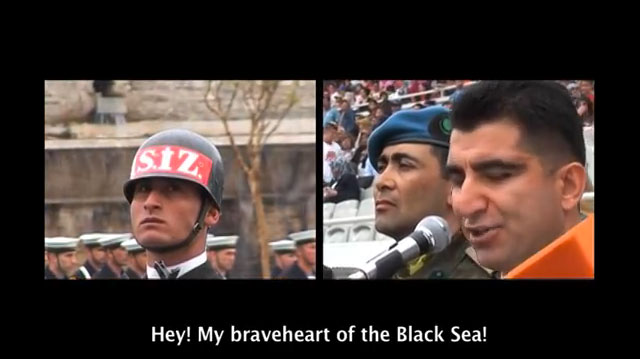
Köken Ergun. I, Soldier (Ben Askerim), 2005 (video still). Two-channel-video. © Köken Ergun.
LM: In light of this very recent event that reinforced the idea of the Turkish Republic, let’s talk more about the changing role and power of the soldier and the military in Turkey. In putting an end to the countrywide celebration of the National Youth and Sports day, Erdoğan simultaneously diminished the imaginative and iconic power of the soldier – a powerful state-embedded icon – and that of the military as a whole, to make it clear that sociopolitical issues are changing.
KE: Erdoğan first wanted to get rid of the ceremonies because he saw them as belonging to the old republic. He did have an issue with the public image of the army, that’s for sure, and he wanted to put it under his control. So, he had to erase its image from the public memory to become it. He promised people that he would release them from the power of the military and bring them democracy, but, in time, he did just the opposite. He took on all the power himself. By now, we can see his ultimate greed and vanity. Although Erdoğan already controls all the state mechanisms, he still wants more, and this will not end. The public knows that he wants to stay in power to avoid being put on trial, because as soon as he is down, they think he will be judged for the crimes he committed. I think this is exactly why he now appears to be supporting the fundamentals of the Turkish republic. He realised that his Islamist tendencies have not given him enough votes. Now he plays in the middle field, tries to please everyone, and perhaps to avoid a harsher sentence if he is ever put on trial.
LM: Are you familiar with the black-and-white images of the sports parades that took place in Moscow under Stalin’s rule in 1936 in Red Square? Alexander Rodchenko took some photographs of the parade at the moment in time when modern sports came into being, and when Stalin ordered the parade to take place annually. This was also the time when Leni Riefenstahl made her propaganda film that documented the Nazi Party Congress in Nuremberg in 1935, which were followed by her two Olympia films. Interestingly, the Soviet sports parades started to take place about at the same time as the Turkish ceremonies. In Russia, they were invented to create a collective feeling of togetherness and to connect the people with national politics – the party in power – especially with the leader of the Soviet Union, Joseph Stalin from the late 1920s until his death in 1953.
KE: That was also what Atatürk, the founder of the Turkish republic, tried to do when he created his nation state in 1923 after the Ottoman Empire dissolved. He borrowed some concepts from the Soviet model. Following his death, his republican party, which ruled Turkey under the single party system until 1945, applied these concepts and forms to the National Youth and Sports Day ceremonies. They looked at the nation-building model of the Soviets and the Nazis and copied some of their ritual forms. That is why my work I, Soldier can be perceived as reminiscent of Rodchenko’s and Leni Riefenstahl’s work.
LM: Here, I think it is also important to point out that, when you look back at the very first parades in Russia and the reason for which they were invented, it becomes obvious that the National Youth and Sports Day celebration was ended much later in Turkey.
KE: Yes, and, furthermore, the people who hate Erdoğan – as the last referendum has shown, we are talking here about nearly 50% of the population – are somewhat nostalgic about the sort of stability the army gave them. These people empathise with military coups and would like to see the military receiving some of its powers back. This is ridiculous, but it shows how desperate they are with the current political situation. I think that their hope for another coup probably goes back to their lost hope of having free elections under Erdoğan. And in this regard, a new image of the soldier starts to emerge. Under the current state of emergency, anyone sympathising with the military coup can be labelled a terrorist, so people who are supportive of the military are discreet now. But if they were given a chance, they would not hesitate to verbalise or visualise their worship of the soldier cult.
LM: As the Turkish military has lost its official powers, what do you think a new public image of the Turkish soldier could look like when taking into consideration the advancing techniques of war, such as the usage of drones and robots. Are the physically skilled soldiers that we are familiar with becoming more and more useless?
KE: That’s difficult to say. In Turkey, we could now say that the image of the soldier has been victimised by Erdoğan. Even in recent opinion polls, when asked who they trust the most – politicians, intellectuals, or the army – a large number of people still answer the army. I think part of this goes back to Erdoğan’s victimisation of the army, first by taking some of its members to court during the Ergenekon trials of 2008-10 and then by declaring them the suspects of the failed coup attempt against him in 2016. However, we still don’t know who was behind the coup. Many people don’t think the army did it. They think it was misused by the Gülen community, who have planted their own men into the army for more than 30 years in rather sinister ways. This disbelief seems to foster a nostalgic feeling for the army that Atatürk founded. He was a soldier himself. In fact, some opponents of Erdoğan regard themselves as “Atatürk’s soldiers”. So I think the contemporaneous public image of the Turkish soldier is in itself reminiscent of the idea of the soldier during Atatürk’s reign.